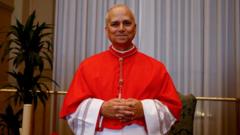On May 8, 2025, Pope Leo XIV steps into the papacy amidst hopes for reconciliation and reform within the church.
New Era for the Catholic Church: Pope Leo XIV Takes Office

New Era for the Catholic Church: Pope Leo XIV Takes Office
Pope Leo XIV's election marks a pivotal moment for the Catholic Church as he becomes the first American pope.
Pope Leo XIV stepped onto the balcony overlooking St. Peter’s Square in Vatican City on Thursday, officially assuming his role as the leader of the Roman Catholic Church. The announcement came shortly after 6 p.m. when white smoke emerged from the chimney of the Sistine Chapel, signaling the election of a new pontiff, a moment celebrated by crowds both in the square and across the globe.
Dressed in the white and red vestments symbolic of his position, Leo XIV, born Robert Francis Prevost in Chicago, shed his cardinal attire, marking a historic moment as the first American pope. His election follows the passing of Pope Francis in April and concludes a conclave that lasted just over 24 hours. This conclave was significant, not only for its quick outcome but also as the largest gathering of voting-age cardinals, many appointed by Francis.
As Leo XIV begins his papacy, the Catholic Church faces considerable challenges and uncertainties, particularly around whether to pursue Francis’ agenda of reform or revert to a more conservative approach. In anticipation of the conclave, Leo XIV was positioned by his supporters as a “dignified middle of the road” candidate, which may play a crucial role in unifying the church's diverse factions. The excitement and jubilation felt in St. Peter’s Square, with crowds stretching towards the Tiber River, reflect the hope that Leo XIV's leadership can navigate the complexities of modernizing the Church while honoring its traditions.
The announcement of “Habemus Papa,” or “we have a pope,” preceded Leo XIV’s first appearance, resonating deeply with the thousands gathered. As the world watches, Pope Leo XIV’s decision-making will undoubtedly shape the future of the Catholic Church and its 1.4 billion faithful.
Dressed in the white and red vestments symbolic of his position, Leo XIV, born Robert Francis Prevost in Chicago, shed his cardinal attire, marking a historic moment as the first American pope. His election follows the passing of Pope Francis in April and concludes a conclave that lasted just over 24 hours. This conclave was significant, not only for its quick outcome but also as the largest gathering of voting-age cardinals, many appointed by Francis.
As Leo XIV begins his papacy, the Catholic Church faces considerable challenges and uncertainties, particularly around whether to pursue Francis’ agenda of reform or revert to a more conservative approach. In anticipation of the conclave, Leo XIV was positioned by his supporters as a “dignified middle of the road” candidate, which may play a crucial role in unifying the church's diverse factions. The excitement and jubilation felt in St. Peter’s Square, with crowds stretching towards the Tiber River, reflect the hope that Leo XIV's leadership can navigate the complexities of modernizing the Church while honoring its traditions.
The announcement of “Habemus Papa,” or “we have a pope,” preceded Leo XIV’s first appearance, resonating deeply with the thousands gathered. As the world watches, Pope Leo XIV’s decision-making will undoubtedly shape the future of the Catholic Church and its 1.4 billion faithful.























